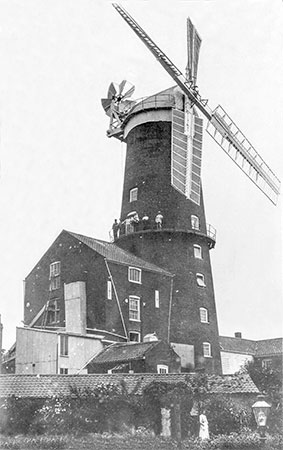
c.1900
Upper Hellesdon Press Lane towermill |
 |
c.1900 |
The towermill in Press Lane, Upper Hellesdon was built in 1875 by Ephraim Witard who then ran the mill and lived nearby with his wife Maria. This was the third mill to be constructed on the same site. The two previous mills were both postmills, an earlier_mill and a later_mill. The new towermill, often known as Witard's Mill, had an imposing nine storey tower with adjoining granaries, ancillary buildings and a steam engine house. |
After the demise of Press's_High_Mill in Gt Yarmouth, which was 102 feet high, Hellesdon Mill became the highest mill in Norfolk. The mill was 88 feet high, the tower being 72 feet and the cap a further 16 feet. |
4 double shuttered sails, each with 10 bays of 3 shutters, struck by rack and pinion powered 4 pairs of stones, a flour machine and an oat crusher. The Norfolk boat shaped cap with a petticoat and gallery held a 6 bladed fan. The 9 storey tower had a stage set around the 5th floor. |
The mill was originally fitted with a cast iron windshaft and the rollers of the bearing used cut through the neck every six weeks. A cast mild steel windshaft was later substituted, having been designed with an eighteen inch neck journal running on three rollers mounted on gudgeons in the neck bearing. The mill tower was 95' to the curb. |
DIED. |
WITARD. - On the 4th inst., Harry Lewis, youngest and dearly-beloved son of Ephraim and Maria Witard, of Hellesdon, aged 9 weeks. Norfolk Chronicle - 19th May 1877 |
DIED. |
WITARD. - On the 13th inst., at Upper Hellesdon Mill, William, the dearly beloved husband of Susannah Witard, aged 46, leaving ten children to mourn their loss. Norfolk Chronicle - August 1880 |
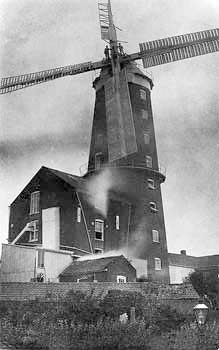 |
Sail repairing c.1906 |
In 1887, the Royal Show was held at Crown Point and Ephraim Witard had a stand, where he erected a roller system from the mill, which he ran all week. The Prince of Wales, later to become Edward VII, visited the stand and was so impressed that he bought a bag of flour to be delivered to Sandringham. |
DEATHS. |
WITARD. - on the 3rd inst., of consumption, George William, the beloved son of W. and M. Witard, of Upper Hellesdon Post-office, aged five years. Norfolk Chronicle - 10th September 1887 |
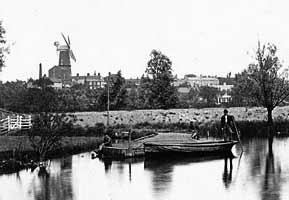 |
View from Heigham c.1890 |
|
Ephraim Witard also ran Felthorpe watermill from c.1891 to c.1912. |
In July 1900, William Witard was fatally injured whilst driving back with a load of corn. |
Inquest at Norfolk and Norwich Hospital by Mr. Coroner Ladell, on Monday 9th July, on death of Mr. William Witard, 43, miller. Albert William Witard, miller, gave evidence of identification. Deceased worked for his father for nearly thirty years. On Wednesday he left the mill at 2.30 with the horse and cart. At 4 o'clock, whilst riding on top of a load of sacks he fell off at the bottom of Ketts Hill and a wheel went over his chest. He died in hospital on Saturday morning. 140 stone on cart and cart itself weighed 13 or 14 stone. Dereham and Fakenham Times - 14th July 1900 |
The 140 stone would appear to have been 5 coombs of barley at 16 stone each and 5 coombs of oats at 12 stone each. |
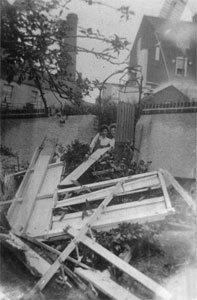 |
Shattered sail 1906 |
The last surviving windmill at Norwich, the Commanding Structure at Hellesdon, owned by that veteran miller, Mr. E. Witard, suffered damage in one of last months thunderstorms, a sail being struck. From the gallery of his mill a view can be obtained stretching for twenty miles towards the coast. The Miller - 3rd September 1906 |
The mill was struck by lightning in 1906 and ran for a time with only two sails before full repairs could be carried out. |
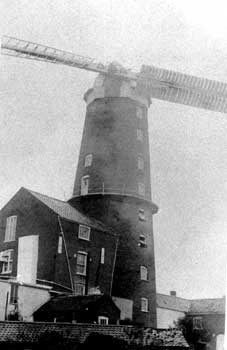 |
Only two sails working c.1907 |
 |
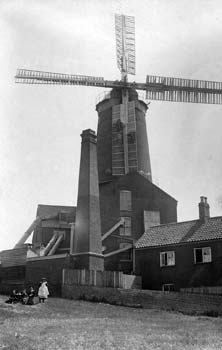 |
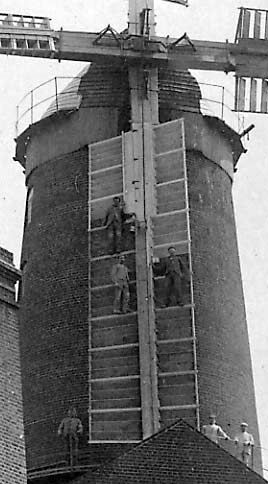 |
Sail repairing c.1907 |
Sail repairing c.1907 |
Closeup from photo on left |
On the 4th May 1913 the mill caught fire. The fire was discovered by P.C. Ephraim Dann at 7.15am. The fire brigade managed to save the upper part of the mill but the bottom of the tower and the adjoining roller mill were burnt out. The cause of the fire was an electrical fault in the roller mill. The mill did not work again. |
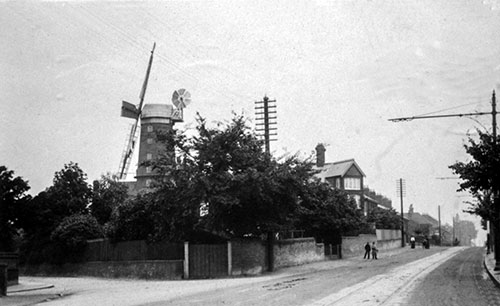 |
Men working on mill sails - 1910 |
NORWICH MILL ABLAZE OVER £7000 DAMAGE DONE |
A most destructive fire occurred on Sunday morning at the extensive premises owned and occupied by Mr. Ephraim Witard known as the Hellesdon Flour Mill, which, situate on the highest part of Aylsham-road, within the city boundary, form a well-known land mark. It was about a quarter past 7 o'c when Police Constable Ephraim Dann made the discovery. The outbreak occurred in the roller mill, the floors of which are connected with those of a lofty brick tower windmill erected in 1876 and over 100 feet in height. The police constable at once gave the alarm and in an incredibly short space of time the motor fire engine and the brigade, accompanied by the Chief Constable (Mr. E. F. Winch), Supt. Hodges and Chief Engineer Shaw, were on the spot. The flames had gained strong hold of the roller mill in which there was a large quantity of stock and some very valuable machinery. The brigade found themselves confronted with a very formidable task. The wooden floors and doors connecting the roller mill with the tower mill were quickly consumed and the flames rapidly spread to the interior of the latter structure. For some time the fire, despite the actively and well directed efforts of the brigade, continued to make progress and it was found necessary to supplement the admirable work which the motor engine was accomplishing by calling into, play the steamer, which added several jets to those already in operation. When the fire had been raging about an hour, the brigade felt some anxiety as to the probability of the huge wind sails attached to the tower mill becoming involved and their exertions were severely handicapped by the great height of the building making it most difficult to attack the flames as they mounted higher and higher towards the top of the lofty structure. Eventually the hose, some 2000 feet of which were altogether employed during operations, was got to work on the circular platform outside the tower, which is a matter of some 55 feet from the ground and from this point of vantage the fire on the seventh floor was successfully attacked. Gradually but surely, the good work of the brigade be3gan to tell and they eventually succeeded in quelling the flames in the tower mill, but the roller mill was completely burnt out. After between four and five hours battling with the consuming element, the firemen, who had put up a fight worthy of the highest praise, were able to withdraw the motor and steam engines. The granary, which was also connected with the main building and contained a large number of sacks of flour and other stock, was severely damaged by water. The premises were insured in the County Fire Office for £7000, an amount which Mr. Witard estimates will by no means cover the loss he has sustained. "This," said the Chief Constable to one of our representatives, "was one of the most difficult fires the brigade has ever had to deal with and the men did most excellent work. As showing the value of the motor engine, it may be stated that the person who sent the telephone message from the scene of the outbreak to the Fire Brigade quarters states that the period which elapsed from the moment he sent the message to the arrival of the brigade on the spot was four and a half minutes and as the distance to be traversed from one point to the other is upwards of a mile, it will be readily seen that no time was lost." Norfolk Chronicle - 9th May 1913 |
A disastrous fire broke out on the premises of Mr. E. Witard at Upper Hellesdon, Norwich on Sunday. The lofty brick tower windmill, one of the most prominent landmarks of the city, had at its base a roller mill and this was completely destroyed, involving the loss of several thousand pounds . . . Dereham & Fakenham Times - 10th May 1913 |
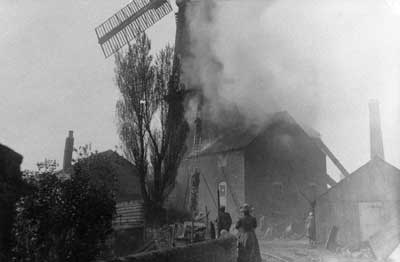 |
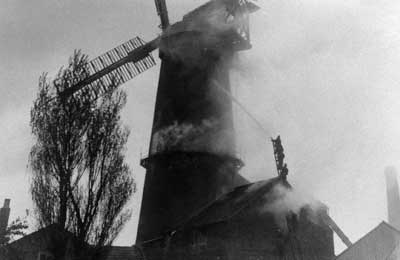 |
|
Mill on fire 4th May 1913 |
Fireman trying to save the mill 4th May 1913 |
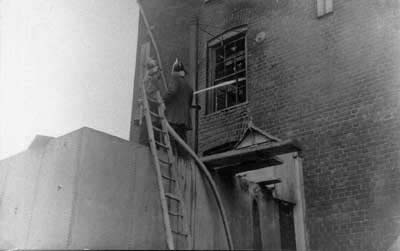 |
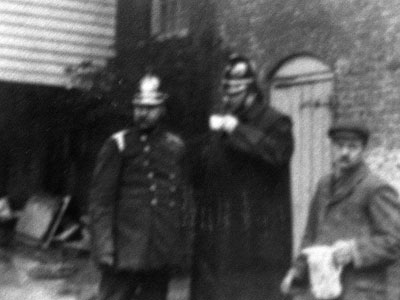 |
Fireman hosing down 4th May 1913 |
Firemen with miller Ephraim Witard providing drink |
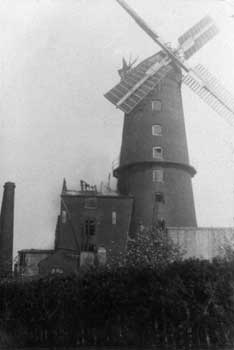 |
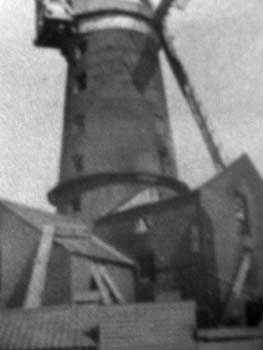 |
Fire aftermath May 1913 |
|
Harry Pointer took over the mill yard for his lorries. The mill was demolished in 1920 and the bricks were used to build council houses in Angel Road. Sutton_mill then took over the mantle as being the tallest mill in the county. |
10 floor tower and 110 feet high, 95 feet to top of brickwork. At one time had sails with 10 bays of three shutters. Two sails went to Paston_Mill for which they were shortened by 2 bays. According to Dan England, Upper Hellesdon Mill once had a cast iron windshaft, which cost £200, with a three-roller neck bearing. The rollers cut through the 18" neck journal of the shaft in six weeks. How it was put up is not on record, but in about 1910 a new shaft was put in Hindolveston_Mill and block and tackle and horses were used to pull it up. Upper Hellesdon Mill was probably the last corn mill to be built in the county; erected in 1875 it was demolished in 1920. (Croxton Mill was built in 1885) Rex Wailes - 13th April 1949 The cast iron windshaft was replaced with another made of mild steel |
Mr. H. E. Witard, the City Council Alderman, brings me some interesting notes . . . He was reminded of another mill, known as Upper Hellesdon Mill, which stood between Aylsham Road and Press Lane. The owner was the late Ephraim Witard, whose son Albert, the last of the family engaged in milling, died just over a week ago. This mill, with its red brick tower, was a landmark for miles around. It was built in 1875, and was claimed to be the tallest in Britain. The site on which it was built was that of an old post mill which was acquired by the late Ephraim Witard, but evidently it did not suit this enterprising man, who had it demolished to make room for a more up-to-date building. There were nine floors, which were topped by a great dome--shaped cap. The four sails were each over 60 ft. in length. (each pair) Alas, this mill was gutted by fire in 1911. An electric power plant had just been installed, and Mr. H. E. Witard says it was believed that some defect in the wiring was the cause of the fire. . . . brick from "Witard's Mill" were used in building the Council houses on Angel Road Estate in 1919. Mr. Albert William Witard was among the last trader craftsmen who used wind-power to produce flour in Norwich. Eastern Evening News - December 1954 or January 1955 |
Best remembered of these big tower mills, however, was Witard's Mill, Lower (Upper) Hellesdon, built by Ephriam (Ephraim) Witard in 1873 (1875) on the site of St. Clement's Mill, an old postmill dating from the 1820s or even earlier. This giant, which had four sails each over 60 ft in length, (each pair) survived until 1913, when it fell victim of fire, one of the oldest enemies of mills. When windmills ground the city's flour, R.W.M., Eastern Daily Press - 13th April 1970 |
Mr. W. L. Duffield said, 1948, a tall tower of 9 or 10 floors and four pairs of stones. The inside was burnt out when the roller mill was also destroyed by fire. Down 35 years. Rex Wailes says burnt out 1914, having been struck by lightning two years running. H. E. S. Simmons - June 1973 |
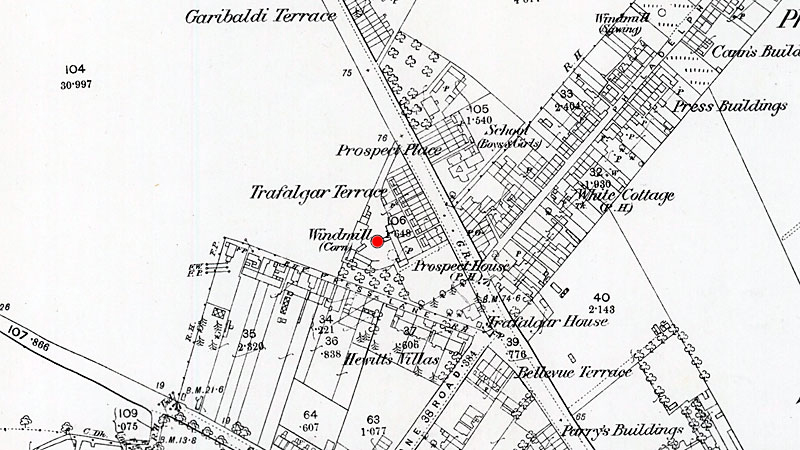 |
O. S. Map 1883 Mill marked in red with New Catton Philadelphia sawmill top right Courtesy of NLS map images |
Kelly's 1900: William Witard, corn & flour dealer, 109 Aylsham Road Kelly's 1904: Albert William Witard, householder, Mill House, Presses Lane, Hellesdon |
1875: Mill built by Ephraim Witard 1878: Ephraim Witard, miller Hamilton's 1879: Ephraim Witard, miller at the Tower Mill, Upper Hellesdon Road
Eyre's 1883: Ephraim Witard, miller & corn merchant, Aylsham road 1885: Ephraim Witard elected one of the overseers for Hellesdon White's 1888: Ephraim Witard, miller & corn & cake merchant, Upper Hellesdon Road and Corn Exchange 1892: Ephraim Witard, miller 1896: Ephraim Witard, miller Kelly's 1900: Ephraim Witard, miller (wind & steam) & corn & cake merchant, Aylsham Road July 1900: William Witard fatally injured whilst driving back to the mill with a load of corn Kelly's 1904: Ephraim Witard, miller (wind & steam) & corn & cake merchant, 94 Aylsham Road August 1906: Mill damaged in thunderstorm with a sail being struck by lightning and blown off 1907: Mill working with two sails
Jarrold's 1911: Miller, Upper Hellesdon Mills, Aylsham Road 1912: Ephraim Witard, miller Sunday 4th May 1913: Mill destroyed by fire 1920: Mill demolished with the bricks being used to build council houses in Angel Road |
If you have any memories, anecdotes or photos please let us know and we may be able to use them to update the site. By all means telephone 07836 675369 or
|
Nat Grid Ref TG22251027 |
1875 to 1920 |
|
| Historical material within this page © Michael Roots & Jonathan Neville |
Web design and website © Jonathan Neville 2018 |